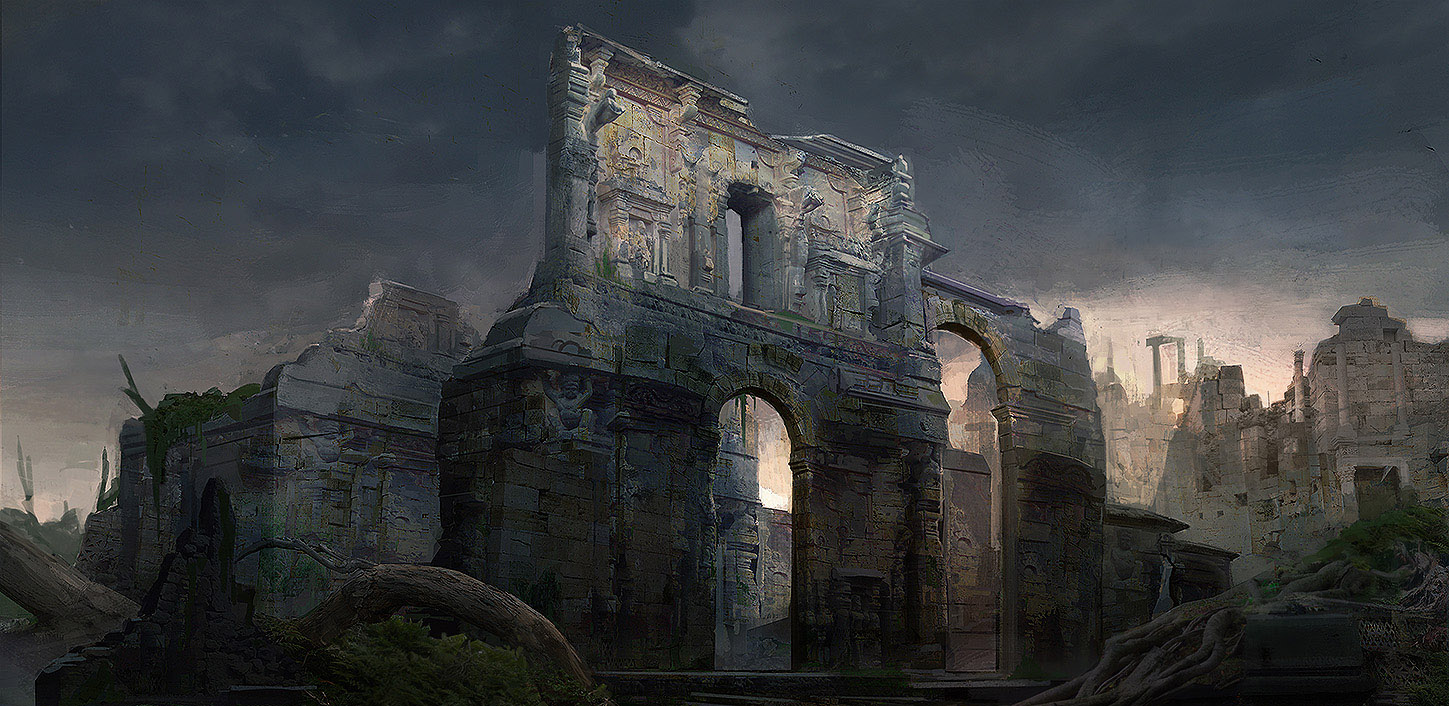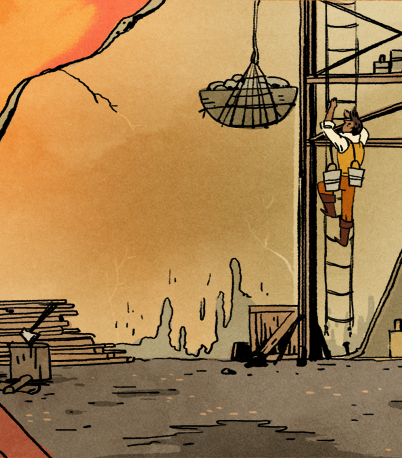New Valara
New Valara has been through a lot. The current name was given to it when the city rebuilt itself after the Third Valaran Revolution. It's been through a lot of names, too. Over the last 500 years, its official names have been: Valara Academy, then Free Valara, then Glåya Repulic, and then Academy City, before finally being renamed for what its citizens hope is the last time.
Each of the name changes represents a distinct period of Valaran history, and most of them have been pretty bleak. After the Fourth Reckoning, the city went through centuries of corrupt, oppressive governments before ultimately ending in ruins around the start of the 5th century after the Reckoning.
The city is still in ruins, but the residents are doing their best to make a home of it anyway. They squeeze new homes and shops between the crumbling remains of the old city, repurposing stone and still-standing walls where they can. Today, most of the residents aren't old enough to remember the Third Revolution, but growing up on the battlefield and surrounded by the destruction has left its pallor on residents. Locals are known to be hearty, stubborn, and overly fond of their home, mangled though it may be. After all, you'd have to have deep roots in a city to keep living there even after it was reduced to rubble.
Each of the name changes represents a distinct period of Valaran history, and most of them have been pretty bleak. After the Fourth Reckoning, the city went through centuries of corrupt, oppressive governments before ultimately ending in ruins around the start of the 5th century after the Reckoning.
The city is still in ruins, but the residents are doing their best to make a home of it anyway. They squeeze new homes and shops between the crumbling remains of the old city, repurposing stone and still-standing walls where they can. Today, most of the residents aren't old enough to remember the Third Revolution, but growing up on the battlefield and surrounded by the destruction has left its pallor on residents. Locals are known to be hearty, stubborn, and overly fond of their home, mangled though it may be. After all, you'd have to have deep roots in a city to keep living there even after it was reduced to rubble.
Demographics
Government
Their government is rather informal. The leader is the mayor, who is currently the man who brought the survivors of the revolution together and became their leader naturally. How he will be replaced is yet to be decided.
Other tasks in the city are run by a loose council. People get appointed by being someone who steps up and offers to do the job, and the mayor assigns it formally. If multiple people offer to do the job, the mayor picks one to be the boss and that person can delegate to the other(s) as needed. Some of these managers are in charge of construction, food and water, healthy and safety, defense, education, or the treasury.
Other tasks in the city are run by a loose council. People get appointed by being someone who steps up and offers to do the job, and the mayor assigns it formally. If multiple people offer to do the job, the mayor picks one to be the boss and that person can delegate to the other(s) as needed. Some of these managers are in charge of construction, food and water, healthy and safety, defense, education, or the treasury.
History
Valara Academy
The first and longest era. The city began as a school built in the countryside. Over time, the school grew and grew. Student and staff residences began to look like neighbourhoods. The academy become a small town, which attracted more and more people to the promise of jobs at the school (not just teaching, but cleaning, cooking, administration, and then shops to serve all those people).
The academy grew into a self-sufficient city-state, until there were people born there who had nothing to do with education but still lived "on campus". After the academy annexed a nearby school, the rector of the school declared himself emperor and established the Valaran Empire. For 800 years, Valara Academy served as the capital of the most powerful empire in the Fourth Age, the definitive hub or academia.
The academy grew into a self-sufficient city-state, until there were people born there who had nothing to do with education but still lived "on campus". After the academy annexed a nearby school, the rector of the school declared himself emperor and established the Valaran Empire. For 800 years, Valara Academy served as the capital of the most powerful empire in the Fourth Age, the definitive hub or academia.
Free Valara
After the chaos of the reckoning, the empire collapsed and its various constituencies went back to being independent city states. In Valara, the rector of the academy was killed. The board of directors took over administration and prioritized recovering money from every former student who was still in debt from student loans.
The result of this was a period of history dominated by financial gain. Those in debt lost their freedom of movement until they repaid the academy. The academy allowed people to take out additional loans to support themselves while all of their earnings went to their loans. These loans also had to be repaid. The result was an endless cycle of debt that kept all but a small minority in poverty. Because an academy education was required for almost all jobs, not gaining an education was not a way to avoid this poverty.
The result of this was a period of history dominated by financial gain. Those in debt lost their freedom of movement until they repaid the academy. The academy allowed people to take out additional loans to support themselves while all of their earnings went to their loans. These loans also had to be repaid. The result was an endless cycle of debt that kept all but a small minority in poverty. Because an academy education was required for almost all jobs, not gaining an education was not a way to avoid this poverty.
Glåya Repulic
The republic was a reaction to the dystopia created by the Valaran board of directors. The First Valaran Revolution overthrew the people in power in Free Valara and attempted to create a better society.
After the revolution, the leaders set themselves up as the new government. After the abuses of the academy in the past, the new government had a distinct anti-intellectual bias. They abolished currency and enacted a policy of supplying anything people needed to live for free, and any luxuries could be bartered for.
This quickly ran into problems when they did not have enough supplies to give sufficient amounts to every citizen. The standards for "as much as you need to live" dropped, while a blackmarket sprung up to supply these things. Corruption sunk into the government. After several horrific human rights violations, another revolution began to stir.
After the revolution, the leaders set themselves up as the new government. After the abuses of the academy in the past, the new government had a distinct anti-intellectual bias. They abolished currency and enacted a policy of supplying anything people needed to live for free, and any luxuries could be bartered for.
This quickly ran into problems when they did not have enough supplies to give sufficient amounts to every citizen. The standards for "as much as you need to live" dropped, while a blackmarket sprung up to supply these things. Corruption sunk into the government. After several horrific human rights violations, another revolution began to stir.
Academy City
Academy City was an attempt to return Valara to the glory it had in the Fourth Age. At the end of the Second Valaran Revolution, the leaders of the military took control of the city. The re-instituted the currency used during the days of Valara Academy and opened the academy once more. However, their version of the academy was strongly focused on glorifying Valara and education was strictly censored.
The theory of Academy City leaders was that they needed a firm hand to guide the wayward city back to its former greatness. They erected statues and monuments to Fourth Age leaders, forbade public criticism of the city or its government, and set out to "purify" the city of political dissidents, foreigners, or academics who didn't toe the party line. For people who were ethnically Rall and went along with the governments wishes, this was the best life had been in Valara in centuries. For anyone else, it was a nightmare.
The theory of Academy City leaders was that they needed a firm hand to guide the wayward city back to its former greatness. They erected statues and monuments to Fourth Age leaders, forbade public criticism of the city or its government, and set out to "purify" the city of political dissidents, foreigners, or academics who didn't toe the party line. For people who were ethnically Rall and went along with the governments wishes, this was the best life had been in Valara in centuries. For anyone else, it was a nightmare.
New Valara
The current iteration of the city, and one hoping to endure for generations to come. The Third Valaran Revolution was horribly destructive. Civil war raged through the streets for months, before resulting in a fire that consumed 3/4 of the city. The fire was only extinguished by a freak storm, with strong winds that further damaged the buildings. In the end, both the leaders of the revolution and the leaders of Academy City were dead.
For once, the leaders of the revolution were not around to impose a new horrible order. One man, Emin Balazas, arose as a leader among the survivors. He didn't set out to be a ruler, but his charisma, organization skills, and dedication to Valara made him a natural leader. Once the town was relatively functional again, the community asked him to become mayor, and he agreed.
For once, the leaders of the revolution were not around to impose a new horrible order. One man, Emin Balazas, arose as a leader among the survivors. He didn't set out to be a ruler, but his charisma, organization skills, and dedication to Valara made him a natural leader. Once the town was relatively functional again, the community asked him to become mayor, and he agreed.
Type
Large town
Population
20,103
Cover image:
Antediluvian City
by
Ananda C. Arán



